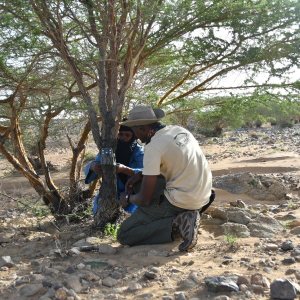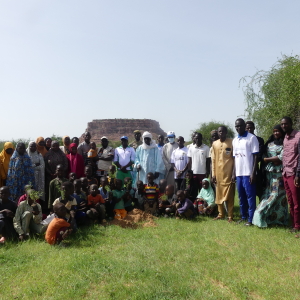Niger, Sahel: the end of the migration route for an Egyptian vulture from Bulgaria
At the beginning of October, the management unit of Gadabeji Game Reserve (GGR) has been supported by the Sahara Conservation Fund and the project Niger Fauna Corridor to carry out a mission in the vicinity of the reserve to collect information about a tagged captive bred Egyptian vulture released in Bulgaria.

The Sahel and Sahara is on the flyway of the Egyptian vultures migration routes as they fly over Chad and Niger every year, from the Balkans and in particular from Bulgaria and Greece. To protect the species along its flyway, the Egyptian Vulture New LIFE project funded by the European Union is initiating an innovative collaboration between several partners including the Bulgarian Society for the Protection of Birds – BSPB and the Sahara Conservation Fund.
Like few years ago for the Egyptian Vulture Paschalis , the Bulgarian Society for the Protection of Birds, contacted us because they had lost track of one of the Balkan Egyptian vultures, recently tagged and equipped with GPS/Satellite transmitter. The last location received by BSPB was in Niger, in the vicinity of Gadabeji Game Reserve.
SCF informed their partners from the Niger Fauna Corridor Project and the management unit of Gadabeji Game Reserve to investigate and find out what had happened to this Egyptian vulture. 5 years ago, Paschalis from Greece had been killed in Niger next to Koutous Massif, by a poacher from Nigeria for a belief-based use named locally “Juju”. It was also a good opportunity to raise awareness with the local communities about the diversity of the vulture species located in this part of Niger and as well to outline their huge role as ecosystem service provider and its importance in the overall biodiversity management.
The endangered Egyptian vulture
The Egyptian vulture (Neophron percnopterus) roost communally on large trees, electric poles, buildings or on cliffs, and prefers open spaces (grasslands and plains) for foraging.
Scientists have documented the large population decline in the 20th century for many well-known reasons (hunting, habitat destruction, poisoning, nest destruction, egg collection and more recently poaching for “blood money” purposes).
Vultures are now fully protected at an international and national scales. Some of the African vulture status has been uplisted two years ago by the IUCN red list .
The Egyptian vulture is listed “Endangered” by the International Union for the Conservation of Nature’s red list since May 2007. The red list is increasingly used to raise public’s and policy makers awareness on the species threatened with extinction.
How the animal was finally found
Thanks to the last signal sent by the transmitter, the rangers from the Gadabeji Game Reserve were able to find the place where the bird had been observed for the last time, 60 kilometers away from East-Gadabeji. In a tiny village, named Aboussa, the traditional ruler and his community helped them to find the transmitter and the ring of the Egyptian vulture which had been poached by two men for bush meat, identified later by the inhabitants of the village. The local people and in particular the children outlined they had never seen this species before in this area, but they usually observe Ruppell’s vultures. Only, the traditional ruler, aged of 65 years old, had seen formerly this species. It is important to mention that the success of this investigation was only made possible thanks to the transcontinental collaboration between conservationists based in the Balkans and Africa.
Raising awareness
During the mission, a meeting was organized by the rangers to sensitize the local communities about vultures. Pictures were displayed, conservation status and protection by law were reminded, and explanations about this tagged bird were provided. More generally, the meeting was also a good way to remind people that it is of common interest to protect together natural resources. Indeed, the ecosystem role of the vulture in the Sahel is actually even more relevant than everywhere else due to little use of veterinary drugs to protect livestock from diseases and the low level of sanitation services.
Sanctions have been taken against the poachers and recommendations made as lessons learned from the missions, such as : extend actions against poaching to the reserve influence zone, keep on raising awareness among local populations living around the reserve, increase communications between the researchers and the protected areas staff.


